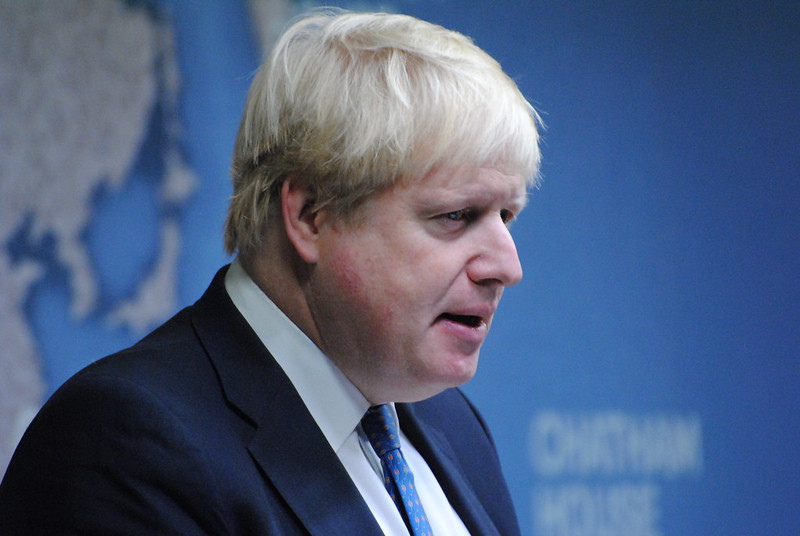Brexit Endgame: Parliament Seeks Extension
Editor's Note: This article originally appeared on Order from Chaos

Published by The Lawfare Institute
in Cooperation With

Editor's Note: This article originally appeared on Order from Chaos
U.K. Prime Minister Boris Johnson has succeeded in amending the unpopular Brexit deal, removing the widely disliked backstop, and replacing it with a revised protocol for Northern Ireland. He brought his new plan to the House of Commons in an unusual Saturday session on October 19; Parliament had required the government to ask the European Union for an extension to the October 31 deadline if the divorce settlement was not approved by that date. But Parliament delayed consideration of his revised agreement, first wanting to ensure the U.K. would not leave the EU without a deal. Johnson begrudgingly asked the EU for an extension, which it is now considering. Parliament is expected to vote on Johnson’s deal this week, with the numbers too close to call.
How did Johnson reach a revised deal with the EU?
In recent weeks, the prospects of revising the Brexit deal seemed bleak after the EU rejected proposals by Johnson’s government to eliminate the unpopular backstop. However, a tête-à-tête between Johnson and Irish leader Leo Varadkar on October 10 identified possible areas of compromise and injected new momentum into talks. Neither side wanted a no-deal exit, and both made significant concessions. Following round-the-clock meetings between negotiators and last-minute phone calls to Johnson, a revised agreement was reached right before Johnson met his EU counterparts at a scheduled summit in Brussels on October 17. EU leaders took less than three hours to approve the new deal, which Johnson and European Commission President Jean-Claude Juncker announced together.
How is Boris Johnson’s deal different from Theresa May’s deal?
Much of the Withdrawal Agreement, which sets out the terms of the divorce, remains the same. This includes the protection of citizens’ rights, the requirement for the U.K. to settle its financial obligations to the EU, and a transition period until December 31, 2020.
The main difference concerns the backstop, an insurance policy that sought to prevent customs infrastructure on the Irish border. The backstop was removed and replaced with a revised protocol for Northern Ireland, which would take effect as soon as the transition period ended. Northern Ireland will remain in the U.K.’s customs territory and Value Added Tax (VAT) area, yet it will align with the EU’s rules in these areas. It will also remain mostly aligned to the EU’s regulations for goods. Four years after the end of the transition period, the Northern Ireland Assembly will vote on whether to continue these arrangements. With the exception of the consent mechanism, the protocol is similar to the Northern Ireland-only backstop initially proposed by the EU and rejected by Theresa May.
The new protocol has four main aspects:
- Regulations. Northern Ireland will remain aligned to “a limited range” of EU single market regulations (e.g., safety standards) on goods and agri-foods. As the U.K. will not continue to follow EU regulations, there will be some checks on goods crossing the Irish Sea (from Great Britain to Northern Ireland).
- Customs. Under the backstop, the entire U.K. would have remained in the EU customs union unless and until alternative arrangements were developed. According to the new protocol, Northern Ireland will remain in the U.K. customs area. Goods moving from Great Britain to Northern Ireland will not be subject to a tariff unless they are “at risk” of continuing to the EU; this will require customs checks. The EU’s customs rules will apply to trade between Northern Ireland and the Republic of Ireland to prevent the need for controls on the island.
- VAT. Value Added Tax was the final sticking point. Northern Ireland will remain in the U.K.’s VAT area but in full alignment with EU VAT laws. The U.K. can apply VAT exemptions and reduced rates in Northern Ireland, as long as they are not lower than rates in Ireland.
- Consent. New provisions were developed to ensure the Northern Ireland Assembly provided “long term democratic support” for these arrangements. Four years after the transition period ends, the assembly will vote on whether they should continue. If the vote passes by a simple majority, they will continue for another four years. If the deal has “cross-community support” (majorities from both unionist and nationalist communities), they will apply for eight more years. If the assembly votes against them, they would lose force two years later; a joint U.K.-EU committee would make recommendations on alternative measures.
Northern Ireland’s Democratic Unionist Party (DUP) opposes the region’s differential treatment, including the application of EU VAT rates there and the introduction of a customs border in the Irish Sea. Although the protocol is more favorable for the U.K. overall, it has raised broader concerns about the longer-term effect of these mechanisms on Northern Ireland. The former British negotiator to Northern Ireland, Jonathan Powell, was sympathetic to DUP concerns. He noted the border in the Irish Sea would grow as the U.K. diverges in regulatory terms, while the introduction of simple majority voting could undermine the principle of cross-community governance. Yet Lord David Trimble, the former leader of the Ulster Unionist Party (UUP) and former first minister of Northern Ireland who opposed the backstop, has urged the DUP to support the revised deal as consistent with the Good Friday Agreement.
What is the Letwin Amendment?
On October 19, Johnson convened an unusual Saturday sitting of the House of Commons — the first time it has met on the weekend since the Falklands War in 1982 — for a “meaningful vote” on his new deal. (May’s government promised in February 2017 to bring the final Brexit deal to Parliament for its approval.) The timing was critical: In early September, Parliament adopted the Benn Act, which required the government to ask the EU for an extended deadline if it failed to achieve parliamentary approval for a deal or a no-deal departure by that date. Johnson had said he would rather “die in a ditch” than request an extension. As a result, some legislators worried that Brexit-supporting members of Parliament (MPs) could support a meaningful vote in order to make the Benn Act obsolete but then refuse to ratify the implementing legislation — thus leaving the U.K. vulnerable to a no-deal departure on October 31.
Sir Oliver Letwin, a former Conservative MP whom Johnson expelled from the party for supporting the Benn Act, introduced the Letwin amendment to the government’s motion on the revised Brexit deal. This amendment, which passed 322 to 305, withholds parliamentary support for the new deal until the underlying domestic legislation has been adopted. Ten former Tory MPs, who were also kicked out of the party last month, backed the amendment alongside most opposition MPs. All 10 members the DUP backed the amendment. Six Labour MPs who represent Brexit-supporting constituencies rebelled to vote with the government. Given the lack of an explicit vote on the amended motion, the Benn Act was triggered and the government was required to request a delay.
Did Johnson ask the EU for a delay?
Despite Johnson’s insistence that he would not “negotiate” an extension, he did send a letter to the EU. (Campaigners have asked the courts to determine whether Johnson’s approach fully complied.) The U.K.’s representative to the EU, Tim Barrow, sent European Council President Donald Tusk an explanatory cover letter with an unsigned photocopy of the extension request required by the Benn Act and a personal letter from Johnson that warned of the “corrosive impact” of a long delay and said “a further extension would damage the interests of the U.K. and our EU partners.” Soon after, Tusk tweeted:
The extension request has just arrived. I will now start consulting EU leaders on how to react. #Brexit
— Donald Tusk (@eucopresident) October 19, 2019
All 27 EU leaders must unanimously agree to grant the extension and on the new date. Their ambassadors met briefly on Sunday to discuss developments. They did not make any decisions beyond starting procedural steps for the revised deal to be legally approved and transferred to the European Parliament for ratification. The EU is expected to grant an extension, with tentative plans for an emergency summit on October 29 if needed, although it will likely wait to respond as British domestic politics unfold. Depending how MPs vote on the withdrawal agreement bill, the EU could grant a short technical extension for ratification procedures to be finalized or a longer extension to enable a second referendum or election.
Is British parliamentary ratification the end of the process?
If the U.K. Parliament ratifies the legislation, the deal still needs to be approved by the European Parliament. There is debate about whether this could occur before the October 31 deadline, as members of the European Parliament are not currently scheduled to meet until November 14 unless an extraordinary session is arranged.
Will Brexit finally be resolved this week?
Johnson attempted to hold a meaningful vote on Monday, which Speaker John Bercow ruled would be “repetitive and disorderly” following the debate on Saturday. The government plans to publish the requisite implementing legislation — the withdrawal agreement bill — on Monday evening. On Tuesday, MPs will have their first opportunity to debate the deal and take a preliminary vote. They are expected to seek amendments, including a second referendum and provisions for the U.K. to remain in the EU customs union. Given its opposition to Johnson’s deal, the DUP has threatened “parliamentary guerilla warfare” and expressed openness to engaging with the Labour Party on its customs union proposals. Although Johnson has gained support for his revised deal, the numbers remain very tight. If he fails to secure agreement, there will almost certainly be new elections.





